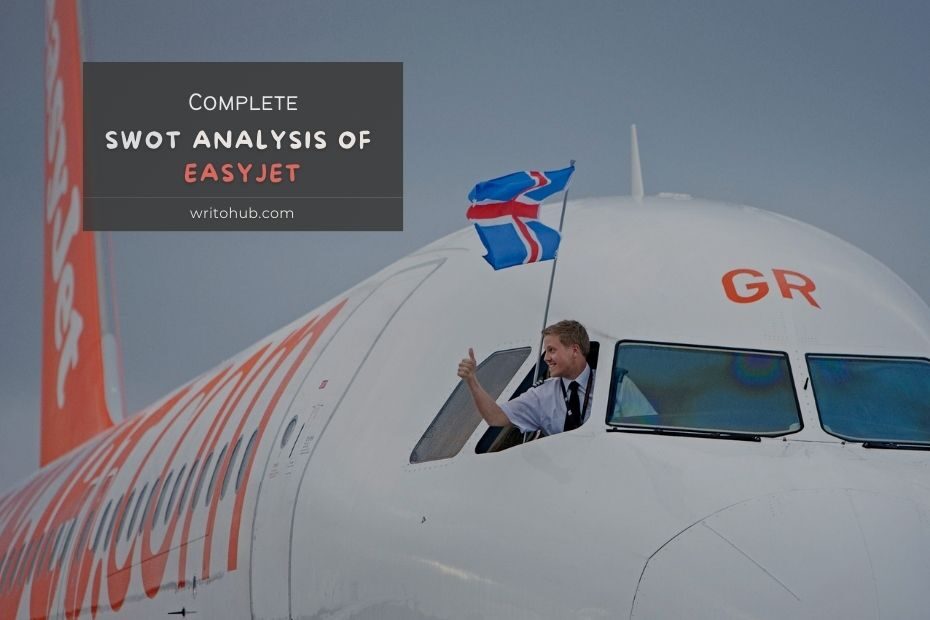easyJet, founded in 1995, is a prominent low-cost airline based in Europe. Conducting a SWOT analysis of easyJet allows us to evaluate its internal strengths and weaknesses, as well as external opportunities and threats.
This analysis provides insights into easyJet’s current market position and helps identify strategic areas for growth and improvement.
Strengths in the SWOT Analysis of easyJet
- Cost Leadership: easyJet is known for its low-cost business model, enabling it to offer competitive ticket prices to customers. The airline focuses on cost efficiency and streamlined operations to maintain its cost leadership position in the industry.
- Extensive Route Network: easyJet operates an extensive route network, serving multiple destinations across Europe and beyond. This broad coverage enhances its market presence and offers passengers a wide range of travel options.
- Strong Brand Presence: easyJet has established a strong brand presence, known for its simplicity, accessibility, and value-for-money offerings. The airline’s orange branding and distinctive livery help it stand out in a competitive market.
- Customer Loyalty: easyJet has a large customer base and a strong focus on customer satisfaction. The airline’s loyalty program, easyJet Plus, provides additional benefits to frequent flyers, fostering customer loyalty and repeat business.
- Operational Efficiency: easyJet’s operational efficiency is a key strength, as it enables quick turnaround times, high aircraft utilization, and on-time performance. This efficiency contributes to cost savings and customer satisfaction.
Weaknesses in the SWOT Analysis of easyJet
- Limited Market Presence Outside Europe: easyJet’s market presence is primarily concentrated in Europe, which leaves it vulnerable to fluctuations in regional economic conditions. Expanding its operations to other regions could help diversify risk.
- Limited In-Flight Services: As a low-cost carrier, easyJet’s focus is primarily on affordable travel rather than extensive in-flight services. This may limit its appeal to passengers seeking a more luxurious or comprehensive travel experience.
- Seasonal Demand Fluctuations: easyJet experiences seasonal fluctuations in demand, with peak travel periods during holidays and summers. Managing capacity and revenue during off-peak periods can be challenging.
- Airport Dependence: easyJet’s operations heavily rely on specific airports, which can lead to congestion issues, limited slots, and dependency on the infrastructure and services provided by these airports.
Opportunities in the SWOT Analysis of easyJet
- Market Expansion: easyJet has opportunities to expand its market presence by targeting new destinations and routes. This includes expanding into emerging markets or underserved regions to tap into new customer segments.
- Ancillary Revenue Streams: easyJet can explore additional revenue streams through ancillary services such as onboard retail, seat upgrades, baggage allowances, and travel insurance. These services can contribute to increased profitability.
- Digital Transformation: Embracing digital technologies and enhancing online platforms can improve customer experience, streamline operations, and drive cost efficiencies. Investing in mobile apps, online check-in, and personalized marketing can enhance customer engagement.
- Sustainable Practices: easyJet can capitalize on the growing demand for sustainable travel by implementing environmentally-friendly practices. This includes investing in fuel-efficient aircraft, carbon offset programs, and reducing single-use plastics.
Threats in the SWOT Analysis of easyJet
- Intense Competition: easyJet operates in a highly competitive market, facing competition from both low-cost carriers and traditional airlines. Intense price competition and capacity expansion by competitors can impact market share and profitability.
- Economic Volatility: Economic downturns, currency fluctuations, and geopolitical uncertainties can impact travel demand and passenger spending. Economic volatility in key markets can pose risks to easyJet’s financial performance.
- Regulatory Environment: The airline industry is subject to extensive regulations and compliance requirements, such as safety standards, environmental regulations, and security measures. Changes in regulations or increased regulatory scrutiny can impact operations and increase costs.
- The shift in Consumer Preferences: Changes in consumer preferences, such as a shift towards alternative modes of transportation or an increasing preference for sustainable travel, can pose threats to easyJet’s business model. The airline needs to adapt to evolving customer expectations.
Conclusion
A SWOT analysis of easyJet reveals its strengths, weaknesses, opportunities, and threats in the aviation industry.
easyJet’s cost leadership, extensive route network, strong brand presence, customer loyalty, and operational efficiency position it as a prominent low-cost carrier.
Addressing weaknesses related to limited market presence outside Europe, in-flight services, seasonal demand fluctuations, and airport dependence is crucial for sustained success.
Seizing opportunities in market expansion, ancillary revenue streams, digital transformation, and sustainable practices can drive easyJet’s growth and enhance customer satisfaction.
Mitigating threats from intense competition, economic volatility, regulatory environment, and shifting consumer preferences requires strategic planning, adaptability, and continuous innovation.
By leveraging its strengths, addressing weaknesses, capitalizing on opportunities, and navigating threats, easyJet can maintain its position as a leading low-cost carrier, offering affordable and convenient travel options to a wide range of passengers.
